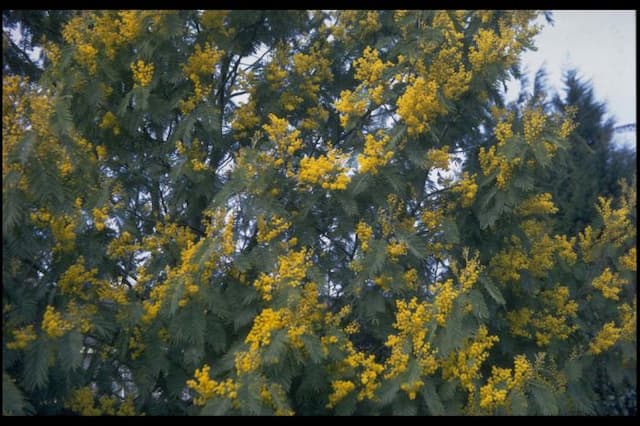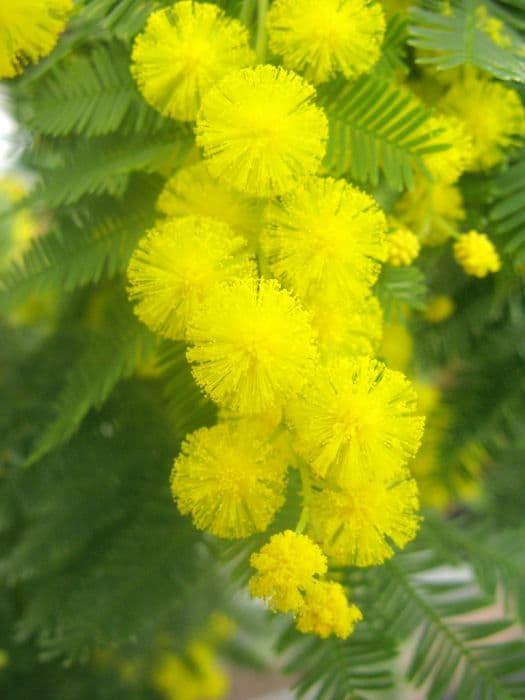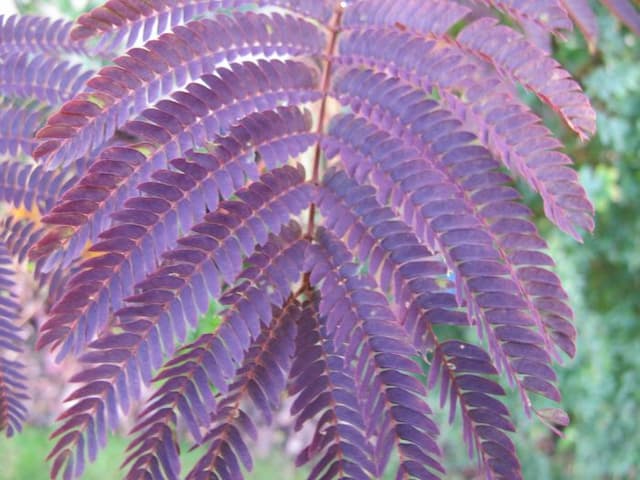Sweet pea Lathyrus odoratus 'Bramdean'

ABOUT
The Lathyrus odoratus 'Bramdean', commonly known as sweet pea 'Bramdean', is a flowering plant notable for its attractive and fragrant blossoms. The flowers are often a striated combination of pink and maroon, presenting a delightful and eye-catching bi-colored pattern. These blooms are typically arranged in clusters, creating a lush display of color. The petals exhibit a classic winged shape, which is emblematic of the sweet pea flowers, giving the appearance of delicate ruffles. The foliage of sweet pea 'Bramdean' consists of green, pinnate leaves that are made up of multiple leaflets. These leaf arrangements spiral up the plant's climbing stems, which are thin and flexible, allowing the plant to twine and cling to support structures with the help of its tendrils. These tendrils are fine, thread-like growths that extend from the leaf axils, curling around any available support to anchor the plant. As a member of the sweet pea family, 'Bramdean' shares the characteristic sweet fragrance that these plants are renowned for. The scent is most pronounced during the cooler hours of the day and evening, adding an aromatic dimension to gardens or spaces where the plant is cultivated.
About this plant
 Names
NamesSynonyms
Sweet Pea, Everlasting Pea.
Common names
Lathyrus odoratus.
 Toxicity
ToxicityTo humans
Sweet pea (Lathyrus odoratus 'Bramdean') is known for its attractive flowers but it does contain toxic compounds, such as aminopropionitrile, that can lead to a condition known as lathyrism if ingested in large quantities. Lathyrism is a neurological disease that can cause weakness and paralysis of the lower limbs, and, in severe cases, may lead to respiratory issues. Symptoms can develop after consuming a significant amount of sweet pea seeds over a prolonged period.
To pets
Sweet pea (Lathyrus odoratus 'Bramdean') is also toxic to pets, including cats and dogs, due to the same toxic compounds that affect humans. If pets ingest the seeds or plant material in large quantities, they can suffer from the same type of poisoning. Symptoms of lathyrism in pets may include lethargy, seizures, and muscle tremors. As with humans, the condition can be serious and potentially lead to paralysis or more severe neurological issues, warranting veterinary attention.
 Characteristics
CharacteristicsLife cycle
Annuals
Foliage type
Deciduous
Color of leaves
Green
Flower color
Varies
Height
5-6 feet (1.5-1.8 meters)
Spread
1 foot (0.3 meters)
Plant type
Climber
Hardiness zones
2-11
Native area
Mediterranean
Benefits
 General Benefits
General Benefits- Aesthetic Appeal: Lathyrus odoratus 'Bramdean', commonly known as sweet pea, features vibrant flowers that enhance the visual beauty of gardens and landscapes.
- Fragrance: Sweet pea is well-known for its delightful scent, which can perfume an entire garden area.
- Attracts Pollinators: The brightly colored flowers attract bees, butterflies, and other beneficial insects that help pollinate the garden.
- Versatility: Sweet pea can be grown in a variety of settings, including beds, borders, and containers, and can also be trained to climb on supports.
- Cut Flower Use: The blooms of sweet pea are excellent for cut flower arrangements, bringing color and fragrance indoors.
- Seasonal Interest: Sweet pea offers seasonal interest in the garden, often blooming from spring to summer.
- Easy to Grow: This plant is relatively easy to cultivate, making it accessible for gardeners of varying expertise levels.
- Color Variety: Sweet pea 'Bramdean' offers a range of flower colors, providing gardeners with diverse design options.
- Educational Interest: Gardening with sweet pea can be educational, teaching about plant growth, care, and life cycles.
 Medical Properties
Medical PropertiesThis plant is not used for medical purposes.
 Air-purifying Qualities
Air-purifying QualitiesThis plant is not specifically known for air purifying qualities.
 Other Uses
Other Uses- Flower arrangements: Sweet pea blooms from the Lathyrus odoratus 'Bramdean' variety are often used in floral arrangements for their delicate appearance and fragrance.
- Companion planting: Gardeners plant sweet peas alongside vegetables like beans and tomatoes as they are believed to improve growth through nitrogen fixation in the soil.
- Natural dye: The flowers of sweet peas contain pigments that can be used to produce natural dyes for textiles.
- Educational purposes: Sweet peas like the 'Bramdean' are used in classrooms to teach plant biology, genetics, and horticultural practices due to their ease of growth and observable traits.
- Artistic inspiration: The vibrant colors and shapes of sweet pea flowers often inspire artists and photographers to create works of art.
- Seed crafts: Dried sweet pea seeds are sometimes used in crafts, such as for making seed mosaics or for inclusion in homemade rattles or musical instruments.
- Garden scent: Planting sweet peas around sitting areas can act as a natural air freshener, creating a pleasant environment in the garden.
- Culinary decoration: Although the plant is not edible, the petals can sometimes be used for ornamental purposes on cakes and desserts after ensuring they are free from pesticides and toxins.
- Perfumery: The essence of sweet pea flowers can be used in creating perfumes or scented sachets, capturing the flower's delicate fragrance.
- Botanical studies: Sweet peas like Lathyrus odoratus 'Bramdean' are often used in genetic studies due to their distinct and inheritable flower colors and patterns.
Interesting Facts
 Feng Shui
Feng ShuiThe Sweet Pea is not used in Feng Shui practice.
 Zodiac Sign Compitability
Zodiac Sign CompitabilityThe Sweet Pea is not used in astrology practice.
 Plant Symbolism
Plant Symbolism- Blissful Pleasure: Sweet pea, which Lathyrus odoratus 'Bramdean' is a variety of, often symbolizes blissful pleasure due to its delightful fragrance and delicate blooms.
- Goodbye or Departure: Sweet pea can also symbolize bidding farewell to someone, as it might have been used historically to say goodbye or to wish someone luck on a new endeavor.
- Thankfulness: The sweet pea can be a way to express gratitude for a lovely time or enjoyable experience, making it a popular choice in thank-you bouquets.
- Delicate or Fleeting Pleasures: Because of its short blooming season, sweet pea can represent the transient nature of pleasure, reminding us to savor the joys of the moment.
- Lasting Pleasure: While it can represent fleeting moments, paradoxically, sweet pea can also symbolize pleasures that last due to its enduring popularity and charm over many generations.
 Water
WaterSweet peas require consistent moisture, especially during their blooming season. They benefit from deep watering about once a week, providing enough water to soak the soil to a depth of 1 inch. In the absence of rainfall, this typically equates to about 0.5 gallons for each plant or until the soil is moist but not waterlogged. Adjust watering frequency according to weather conditions, watering more often during hot or dry periods and reducing the frequency during cooler, damp weather. Ensure that the plant has good drainage to prevent root rot.
 Light
LightSweet peas prefer full sun, with at least 6 hours of direct sunlight each day. They thrive best in a spot that receives morning sun and some partial shade during the hottest part of the afternoon. Avoid overly shaded areas as this can reduce blooms and lead to leggy growth.
 Temperature
TemperatureSweet peas grow best in temperatures between 50°F and 65°F and can survive minimum temperatures down to about 20°F for short periods. They are cool-season plants and begin to decline as temperatures consistently exceed 70°F. To ensure a longer blooming period, plant them in a location where they can stay cooler for longer during the spring season.
 Pruning
PruningPrune sweet peas to encourage bushier growth and more blooms. Pinching off the top of the plant when it reaches about 6 inches in height will help achieve this. Deadheading, or removing faded flowers, can also encourage the plant to produce more blooms. This should be done regularly throughout the blooming season. The best time to prune for shaping is early in the season, just as the plants begin to grow.
 Cleaning
CleaningAs needed
 Soil
SoilSweet Peas thrive in rich, well-draining soil with a pH between 6.0 to 7.5. A best soil mix for Sweet Peas would include one part compost or well-rotted manure to improve fertility, one part garden soil or topsoil for structure, and one part perlite or sand to enhance drainage. Incorporating a slow-release fertilizer appropriate for flowering plants can also benefit their growth.
 Repotting
RepottingSweet Peas, typically grown as annuals, do not usually require repotting. If started in containers, transplant them into the garden once they have strong roots. It is best to sow seeds or plant seedlings directly in their final location outdoors as they do not respond well to transplanting due to their delicate roots.
 Humidity & Misting
Humidity & MistingSweet Peas prefer moderate humidity levels. They can tolerate a wide range of humidity conditions as long as they have good air circulation to reduce the risk of fungal diseases. Avoid overly humid environments which can promote mildew growth on the foliage.
 Suitable locations
Suitable locationsIndoor
Ensure bright light, cool temps, and well-draining soil.
Outdoor
Plant in full sun, compost-enriched soil, and provide support.
Hardiness zone
2-11 USDA
 Life cycle
Life cycleThe common name for Lathyrus odoratus 'Bramdean' is sweet pea. The life cycle begins with seed germination, which occurs in early spring under the right conditions—moist, cool soil. Once the seedlings establish, they enter a period of vegetative growth, developing stems, leaves, and tendrils, with the plant preferring cooler temperatures to grow. Following vegetative growth, sweet pea plants will begin to flower in late spring or early summer, producing fragrant blossoms that may continue throughout the summer if temperatures are not excessively high. Pollinated flowers will set seed pods that mature, eventually drying out and splitting open to release seeds. The plant is an annual, completing its life cycle within one growing season, after which it dies, relying on those self-sown seeds or manual collection and sowing by gardeners to propagate the next generation.
 Propogation
PropogationPropogation time
Spring to early summer
Propogation: Lathyrus odoratus 'Bramdean', commonly known as sweet pea 'Bramdean', is typically propagated through seeds. The best time to sow sweet pea seeds is either in late October to November or from January to March. To propagate by seed, it's beneficial to first soak the seeds in water for 24 hours to soften the seed coat, which can enhance germination rates. Seedlings can then be started indoors in pots or directly sown in the ground, preferable in a well-drained soil. Sow the seeds about 1 inch deep, spacing them about 2 to 3 inches apart. If starting indoors, transplant the seedlings to their final growing location once they have developed several strong leaves and after the danger of frost has passed. Sweet peas climb and will benefit from support provided by trellises or stakes as they grow.









